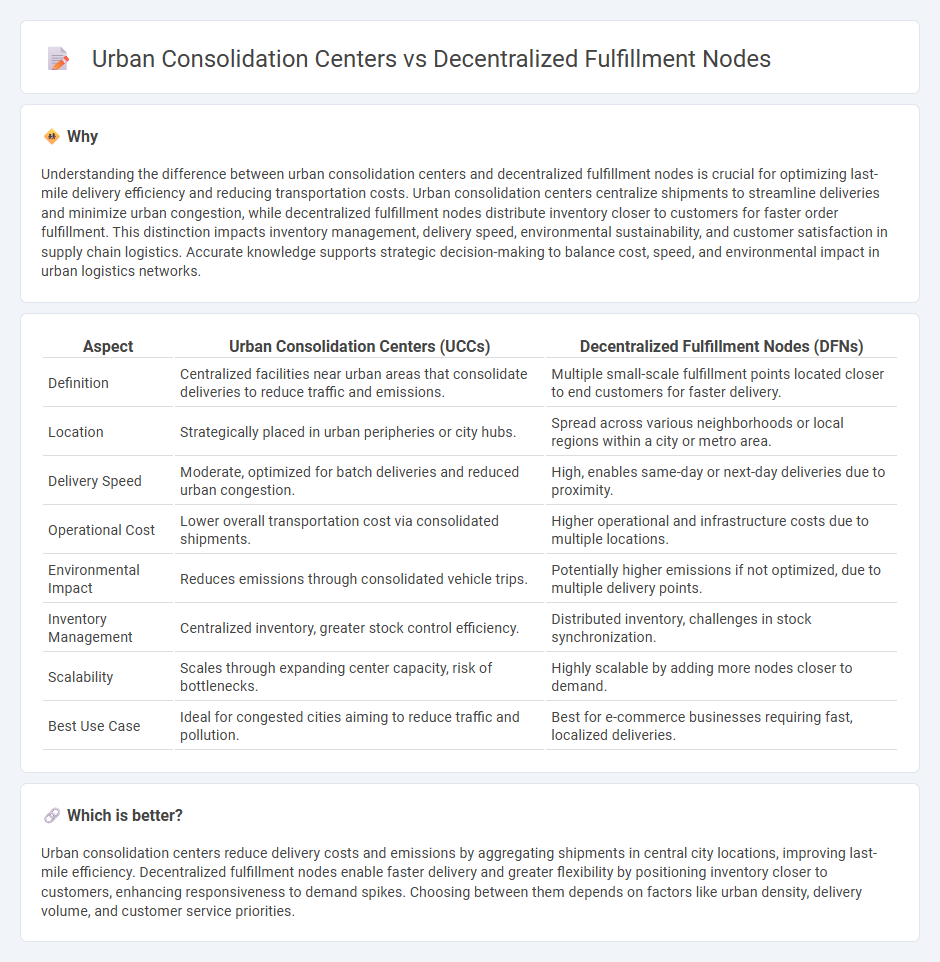
Urban consolidation centers centralize deliveries by aggregating shipments from multiple suppliers to reduce congestion and emissions in city centers. Decentralized fulfillment nodes distribute inventory across various local warehouses, enabling faster delivery and increased flexibility in order fulfillment. Explore the benefits and challenges of these logistics strategies to optimize urban supply chain efficiency.
Why it is important
Understanding the difference between urban consolidation centers and decentralized fulfillment nodes is crucial for optimizing last-mile delivery efficiency and reducing transportation costs. Urban consolidation centers centralize shipments to streamline deliveries and minimize urban congestion, while decentralized fulfillment nodes distribute inventory closer to customers for faster order fulfillment. This distinction impacts inventory management, delivery speed, environmental sustainability, and customer satisfaction in supply chain logistics. Accurate knowledge supports strategic decision-making to balance cost, speed, and environmental impact in urban logistics networks.
Comparison Table
| Aspect | Urban Consolidation Centers (UCCs) | Decentralized Fulfillment Nodes (DFNs) |
|---|---|---|
| Definition | Centralized facilities near urban areas that consolidate deliveries to reduce traffic and emissions. | Multiple small-scale fulfillment points located closer to end customers for faster delivery. |
| Location | Strategically placed in urban peripheries or city hubs. | Spread across various neighborhoods or local regions within a city or metro area. |
| Delivery Speed | Moderate, optimized for batch deliveries and reduced urban congestion. | High, enables same-day or next-day deliveries due to proximity. |
| Operational Cost | Lower overall transportation cost via consolidated shipments. | Higher operational and infrastructure costs due to multiple locations. |
| Environmental Impact | Reduces emissions through consolidated vehicle trips. | Potentially higher emissions if not optimized, due to multiple delivery points. |
| Inventory Management | Centralized inventory, greater stock control efficiency. | Distributed inventory, challenges in stock synchronization. |
| Scalability | Scales through expanding center capacity, risk of bottlenecks. | Highly scalable by adding more nodes closer to demand. |
| Best Use Case | Ideal for congested cities aiming to reduce traffic and pollution. | Best for e-commerce businesses requiring fast, localized deliveries. |
Which is better?
Urban consolidation centers reduce delivery costs and emissions by aggregating shipments in central city locations, improving last-mile efficiency. Decentralized fulfillment nodes enable faster delivery and greater flexibility by positioning inventory closer to customers, enhancing responsiveness to demand spikes. Choosing between them depends on factors like urban density, delivery volume, and customer service priorities.
Connection
Urban consolidation centers and decentralized fulfillment nodes create an integrated logistics network that enhances last-mile delivery efficiency in metropolitan areas. Consolidation centers aggregate shipments from multiple suppliers before transferring goods to decentralized fulfillment nodes closer to end customers, reducing transportation costs and emissions. This connection enables faster deliveries and improved inventory management by leveraging localized stock availability and streamlined distribution routes.
Key Terms
Inventory Distribution
Decentralized fulfillment nodes strategically distribute inventory across multiple locations closer to end consumers, reducing delivery times and shipping costs. Urban consolidation centers centralize inventory in city outskirts to streamline last-mile delivery while alleviating urban congestion and lowering carbon emissions. Explore detailed comparisons to optimize your supply chain inventory distribution strategy.
Last-Mile Delivery
Decentralized fulfillment nodes reduce last-mile delivery times by positioning inventory closer to consumers, leveraging local distribution hubs and minimizing transit distances. Urban consolidation centers streamline deliveries by aggregating shipments, reducing vehicle trips and traffic congestion in dense city environments, improving efficiency and sustainability. Explore deeper insights into optimizing last-mile delivery strategies with decentralized fulfillment and urban consolidation centers.
Cross-Docking
Decentralized fulfillment nodes enable faster local deliveries by positioning inventory closer to end customers, reducing last-mile costs and improving service levels through real-time inventory updates. Urban consolidation centers optimize freight by pooling shipments from multiple suppliers, minimizing urban congestion and carbon emissions, with cross-docking facilitating quick transfer of goods without long-term storage, thereby accelerating distribution cycles. Explore the benefits and challenges of integrating cross-docking in decentralized and urban consolidation strategies to enhance supply chain efficiency.
Source and External Links
Decentralized Fulfillment is Becoming the Ecommerce Gold Standard - Decentralized fulfillment distributes order processing across multiple locations to speed delivery and reduce shipping costs by spreading inventory from a central hub to other fulfillment nodes like marketplaces or third-party logistics providers.
Decentralization of Warehouses in the E-commerce Age - Decentralized fulfillment uses multiple geographically distributed warehouses or fulfillment centers, managed by systems like distributed order management (DOM) and centralized warehouse management systems (WMS), to dynamically route orders for optimal delivery speed and cost efficiency.
Centralized vs. decentralized warehousing: Which is best for your business? - Decentralized warehousing involves multiple strategically located fulfillment nodes near customers to reduce delivery times and shipping costs, offering faster delivery and adaptability at the expense of higher operating costs.
 dowidth.com
dowidth.com